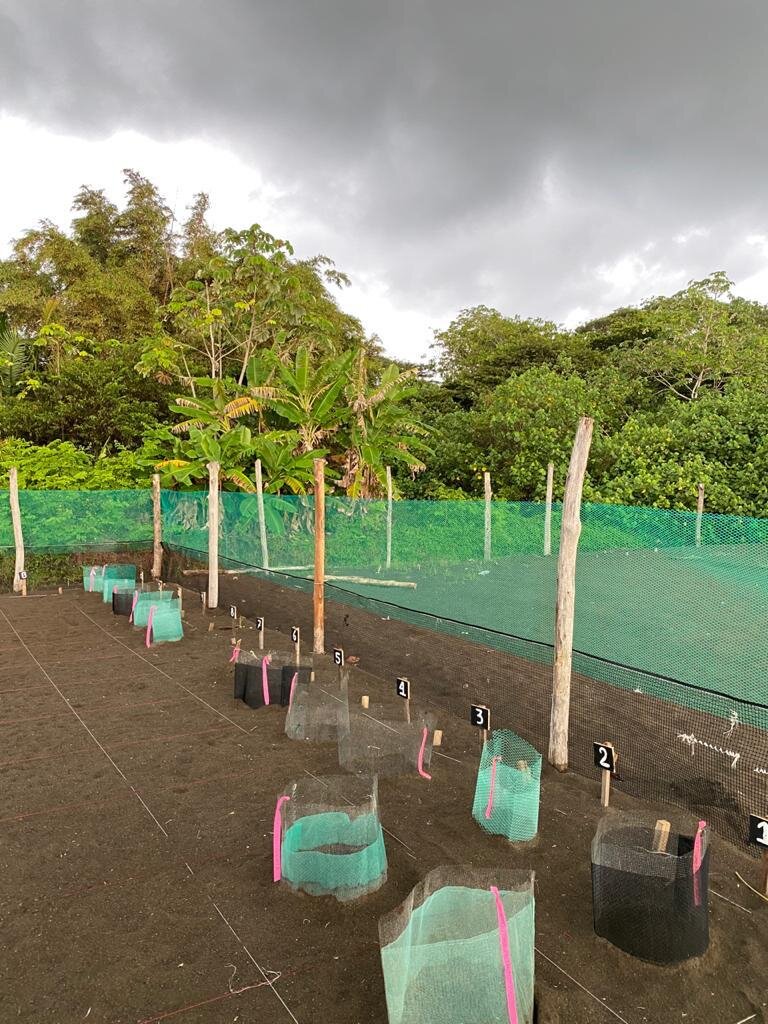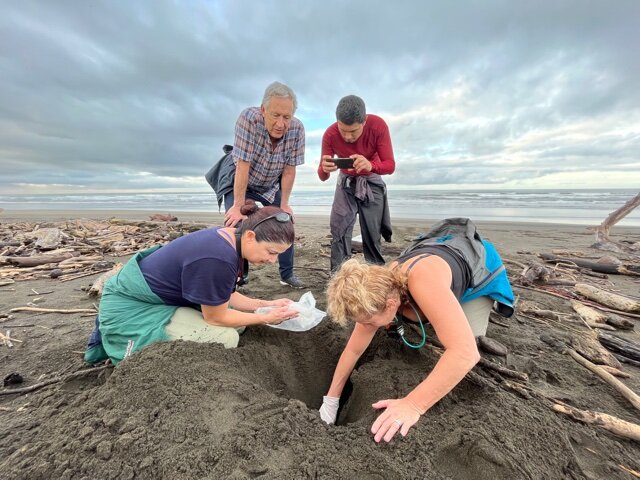By Alejandra Monge | Executive Director
At the beginning of December, Bill our president, and Michelle one of our board of advisors, joined me and my colleague Francisco to visit our project at Punta Mala-Playa Hermosa Wildlife Refuge. Volunteers and the staff walk the beach three times at night, and then they work in the nursery in the afternoon. So we were joining two of the patrols and skip the midnight patrol.
We walked the beach that night from 7:00 to 9:00 p.m. our coordinators and then we walked the beach again for the census in the morning from 4:00 a.m. to 8:00 a.m. We walked about 14 kilometers that morning (8,75 miles). It was a typical “day” work for our sea turtle conservation team. We were exhausted, sleep-deprived, and dehydrated. They were full of enthusiasm and energy. Whoever said, “Youth is wasted on the young,” hasn’t met this fantastic team of staff and volunteers.
The walk at night and especially in the wee hours of the morning was simply unbelievable. The sky was full of stars, and shooting stars were everywhere. The first part of the walk was what we had expected: the midnight team had found several nests and had relocated them in the nursery. Unfortunately, the second part of the walk wasn’t as encouraging. The tide was high, and the midnight team could not cross the river that divided the beach. So that side of the beach was unprotected until we came at 4:00 a.m. It was very sad; we found at least 8 nests depredated during the night. Predators were relentless: coatis and raccoons, crested caracaras, seagulls, and many other birds were also attacking the nests that had been left on the beach.
Life is tough when you are a sea turtle. No wonder they state that only one in one thousand baby turtles survive to reproductive age in natural conditions. Although Punta Mala has lots of natural depredation, the reduction of apex predators such as jaguars, pumas, foxes, coyotes, and ocelots, has produced an overpopulation of sea turtles’ predators such as raccoons and coatis, which makes their survival even harder. And then there is climate change: with tides getting higher and the rain getting more intense, finding appropriate nesting grounds is hard for these remarkable moms.
From eggs to sea turtles their process is very convoluted. The team couldn’t move 222 nests because it was too late to move them by the time we found them. From these 222 nests left on the beach, probably only 10% of the sea turtles will emerge from the nest. Many eggs will be deprecated in the following hours after being laid, some will be dug out from the nest by the raccoons, and then the crabs and the birds will continue eating the eggs and digging for whatever is left. The site is devastating.
The only way to give these crucial animals a surviving chance is by operating a sea turtle project. At our project in Punta Mala – Playa Hermosa, our team of biologists has welcomed 45 volunteers so far this season, and together they’ve protected 213 Olive Ridley (Lepidochelys olivacea) sea turtle nests from the threat of predation, erosion, and poaching. They are removing all these harsh threats from their path until they are ready to swim away.
To provide a clean and secure place to incubate threatened nests, the team spent 29 days back-to-back digging and filtering the sand to build a new hatchery site, with space for up to 276 nests. In addition, they have patrolled the beach every night and walked hundreds of kilometers in the pitch dark, looking for turtles, tracks, and nests.
Thanks to the volunteers and the team, these Olive Ridley Sea turtles have been given a haven, and 13966 baby turtles have already been safely released, and many more will be released by the end of the year. We estimate that at least 18,000 baby turtles will make it to the ocean this year at our beach.
By Robert James | Scientific Coordinator
By Alejandra Monge | Executive Director
Project reports on GlobalGiving are posted directly to globalgiving.org by Project Leaders as they are completed, generally every 3-4 months. To protect the integrity of these documents, GlobalGiving does not alter them; therefore you may find some language or formatting issues.
If you donate to this project or have donated to this project, you can receive an email when this project posts a report. You can also subscribe for reports without donating.
Support this important cause by creating a personalized fundraising page.
Start a Fundraiser
